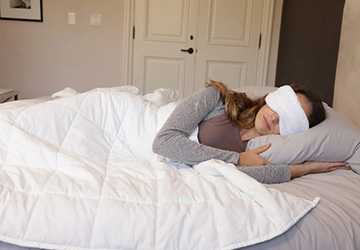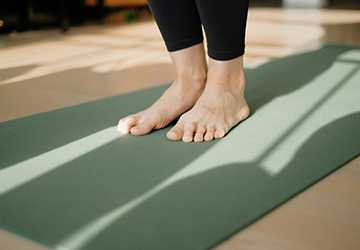What You Need for A Relaxing Sleeping Environment
In our fast-paced society, where worries and fears are constant, getting enough sleep is more important than ever. Getting enough rest rejuvenates our bodies and energizes our minds, paving the way for increased productivity and overall health. But sometimes, finding that deep, calming peace can seem out of reach, especially when our space isn't peaceful. Therefore, it is crucial to create a quiet space that promotes peace. This in-depth guide covers methods and ideas to help you make your ideal oasis of calm, a sanctuary where you can enjoy the healing properties of rest and escape the stresses of daily life.

The value of a cosy lounge.
Before we get into the details, let's consider the importance of creating a quiet resting space. The quality of our rest is greatly affected by the environment in which we rest. Factors such as comfort, temperature, lighting, noise levels and lighting can affect how easily we switch off and relax. By taking advantage of these factors, we can improve the quality of our rest and wake up refreshed.
Eliminate noise pollution.
Noise is a significant barrier to relaxation for many people. Unwanted noise can interfere with your ability to rest and be quiet, whether it's the buzz of electronic devices, a snoring companion or the sound of traffic outside your window. Consider investing in soundproofing tools such as earplugs, a white noise machine, or thick curtains to combat this. Calming your surroundings will allow you to crash peacefully and undisturbed.
Enjoy the power of light.
Light is essential for controlling circadian rhythms, which determine our sleep-wake cycles. Daylight is a natural synchronizer for our body clocks, helping us stay awake and alert during the day. However, too much artificial light can break this cycle, especially at night, and make falling asleep problematic. To create a relaxing atmosphere, you should lower the light intensity in your bedroom before bed. Imagine hanging blackout curtains or blinds so that no light comes in from the outside. This is one of the signals that makes your body feel sleepy.
Optimize humidity and temperature.
Quiet, comfortable and well-ventilated rooms are the perfect place to rest. Regular humidity maintenance can also avoid discomfort caused by dry air or excess moisture. Invest in bedding and mattresses that promote air circulation and regulate body temperature to ensure restful sleep and prevent overheating at night.
Create a comfortable seating area.
The pillows and mattresses you use also help support your body correctly, allowing you to sleep undisturbed. Choose a mattress that prevents pressure points and supports your back. Choose a pillow based on your preferred resting position: side, back, or stomach sleeper. Investing in quality bedding from breathable fabrics like bamboo or cotton can improve sleep hygiene and increase comfort.
Reduce electronic interference.
In the digital age, electronic devices have become the norm, but they can also prevent us from relaxing before bed. The blue light emitted by electronic devices such as computers, tablets, and cell phones reduces melatonin, essential for sleep cycles. By implementing a digital curfew, you can achieve a restful sleep environment by turning off electronic devices at least an hour before bed. Avoid strenuous activity before bed; instead, engage in calming activities such as reading, gentle stretching, or meditation to prepare your body and mind for sleep.
Tips for improving the quality of your rest
In addition to optimizing your rest space as much as possible, you can try these other strategies to improve the quality of your rest:
Establish a regular rest schedule
Regularly following a scheduled bedtime and wake-up routine synchronizes your body's internal clocks, resulting in better sleep. Make sleep a priority, getting seven to nine hours a night and making it part of your daily routine.
Practice relaxation techniques.
Relaxation techniques such as progressive muscle relaxation, deep breathing, or mindfulness meditation can guide the mind to relax and prepare the body for restful sleep. By following these exercises, you can reduce your stress and anxiety levels and make it easier to get healthy sleep.

Reduce caffeine and stimulants.
If you take caffeine or other stimulants before bed, you may have difficulty falling asleep. Avoid caffeinated beverages such as coffee, tea, and soda a few hours before bed and choose caffeine-free alternatives.
Establish a pre-break ritual.
A calming bedtime ritual tells your body it's time to relax and sleep. Whether you drink herbal tea, do gentle yoga, or take a warm bath, you can find something to help you unwind from the day's stresses and find peace.
Regularly evaluate your relaxation space.
Your needs and lifestyle may change, and so will your recreational space. To maintain the best possible resting space, regularly inspect your bedroom for clutter or areas that need improvement. Then, make the necessary changes.
Embrace Aromatherapy
Scents profoundly impact our mood and level of calmness. Adding aromatherapy to your relaxation room can help you feel more comfortable and calm. Essential oils such as bergamot, lavender, and chamomile can be used because of their calming properties. You can use a diffuser to diffuse these essential oils in your bedroom or put a few drops on a cotton ball and place it next to your pillow.
Conclusion:
Equipping your relaxation room with these state-of-the-art methods can make it a more peaceful, calming place to retreat. You can make an oasis of calm and relaxation by enjoying aromatherapy, using rest-friendly techniques, experimenting with resting poses, creating sensory havens, and improving air quality. Always remember that the room in which you sleep affects the quality of your rest. So take the time to create a space that nourishes and rejuvenates your body and mind. Your sleeping paradise is waiting for you to have sweet dreams.







